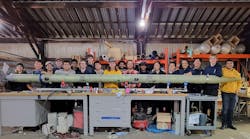Eureka! Berkeley Space Team Rocket Flies High with 3D-Printed Components
University of California, Berkeley students who are part of Space Enterprise Berkeley achieved their goal of throttling and launching the first ever bi-propellant liquid-fueled rocket powered by a collegiate rocketry team. The team worked with Protolabs to manufacture 3D-printed components for the Eureka-1’s (E-1) plenum and parachute system.
The E-1 was three years in the making for the SEB team as part of their ultimate goal to become the first collegiate rocketry team to pass the Karman line, which divides Earth’s atmosphere and outer space. The December launch of the rocket put the team well on its way when it reached more than 11,000 feet in altitude.
3D Printing for Aerospace
With diverse technologies, materials and finishing options, the sky is the limit when it comes to rapid iteration, product development and part production for aerospace. Protolabs supports aerospace engineers throughout the entire product lifecycle, from early prototyping to hot fire testing to launch. Both CNC machining and 3D printing services are often used in aerospace applications such as jet engines, fixtures, brackets and heat exchangers.
The E-1 rocket’s plenum and parachute system were printed via selective laser sintering (SLS) with PA12 40% glass-filled nylon. According to Asa Garner, structures lead, the team researched the options and ultimately chose this material due to its strength, temperature resistance, long-term wear resistance and cost effectiveness.
Keeping it Light with Lattice Design
Lightweighting is a design choice that many aerospace engineers use to minimize component weight without compromising overall strength. Reducing the weight of a part using lattice structures allows for intricate and complex geometries, which Garner opted to do for the plenum and parachute parts.
Garner explains that without 3D printing the team couldn’t iterate on the component designs as quickly as they did for this project. Per Garner, time was the biggest constraint for the team, but they were able to hit their deadlines thanks to the quick nature of 3D printing versus other more traditional manufacturing techniques.
“Both of the critical main parachute bulk heads were entirely 3D-printed and we’re using thermoplastic heat set inserts to fasten them to our primarily fiberglass airframe,” Garner says. “It’s been really nice because, basically, it’s just a lot faster to iterate on them than it would be if we were making them out of aluminum on a CNC machine or something of that matter and we didn’t have to make any compromises on the design. It’s been very convenient to utilize [3D] printed parts on the rocket.”
With quick-turn 3D-printed parts in hand, the team was able use nTopology software to simulate forces on the part and how it would respond when the parachute opened. The lattice design was effective in dissipating stress across the part and leverage the material efficiently.
Absolute End Goal Challenges Rocketry Community
Composed of more than 30 students, each SEB team subsector is responsible for vastly different subspecialties, including avionics, structures, manufacturing, propulsions, E-reg and more—a true, collective team effort.
Check out how the team works together in the video below:
Garner explains that something he enjoys most about the rocketry community is its unique environment; the constraints aren’t arbitrary, and the end goal is absolute, which he says creates an interesting engineering challenge.
Garner and his team plan to use 3D printing and machining for various components in their latest project, the Eureka-2 rocket, which they plan to reach an altitude of 20,000 feet. The key learnings from that launch will pave the way for what the team hopes is a Karman-line surpassing Eureka-3.
Amanda Tierney is 3D printing service line manager for Protolabs.

